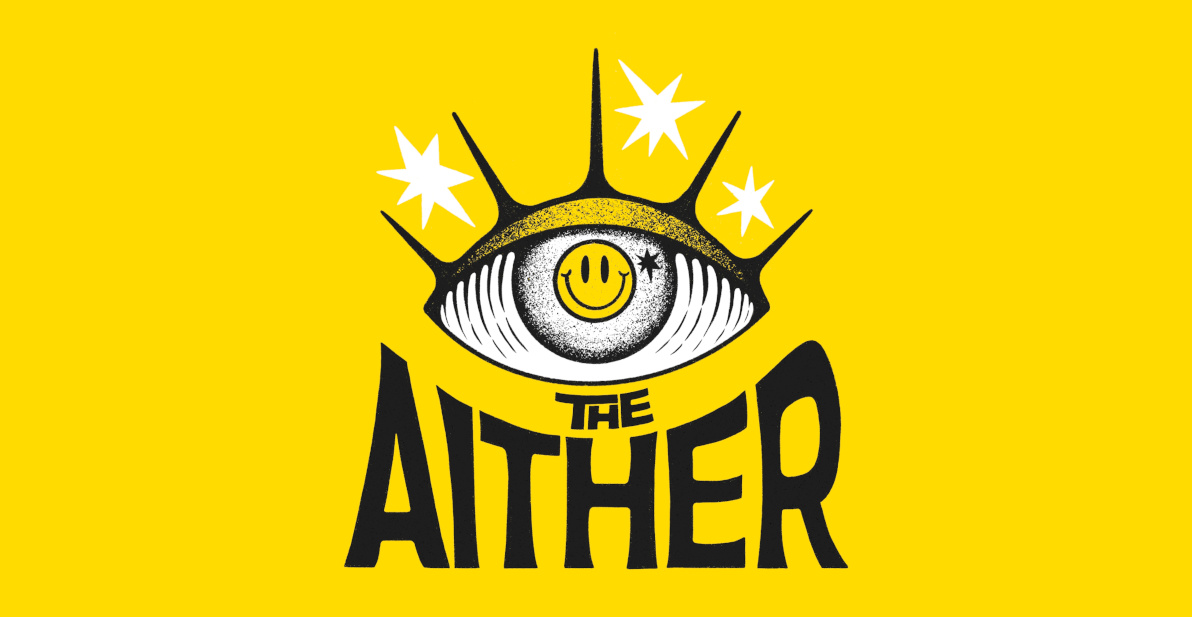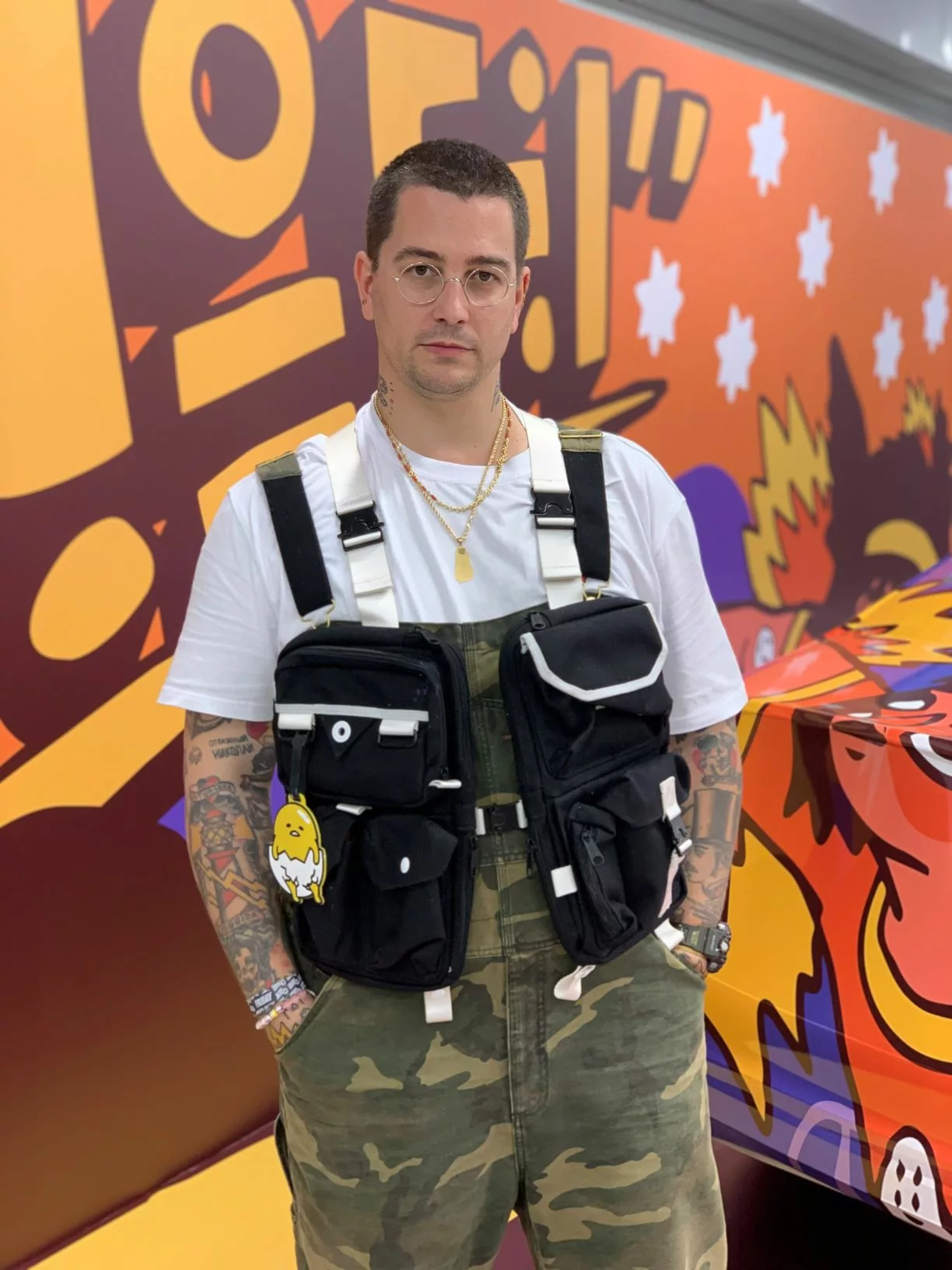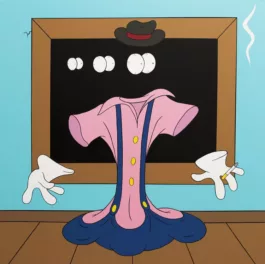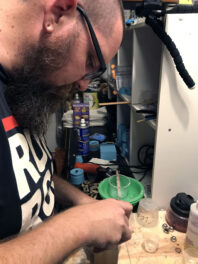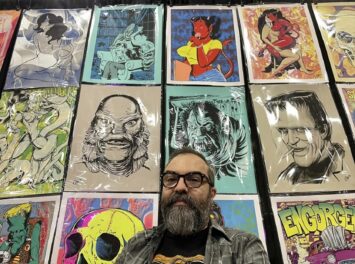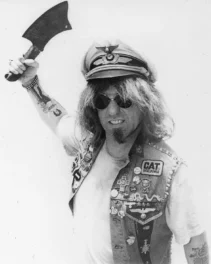Interview by Matt Williams
At the end of 2019 Australian writer, toy collector, sneakerhead and all round good guy Matt Williams interviewed Spanish artist Ricardo Cavolo in person while they were both in Singapore. Were they talked about art, life, mental illness, Ricardo’s four-eye motif, and a whole lot more!
After forgetting about the interview for a while, Matt was lucky enough to recently find it on his hard-drive – and with Ricardo’s consent is allowing us to publish it.
You can read a transcript of their conversation below…
Matt: So we’ll wind back things back to the start, for you where did your artistic journey begin?
Ricardo: Well the thing is I’m doing different things, I can paint murals or work on my own books, exhibitions or collaborations with brands. It depends on the project that week.
I mean if I painted a mural in another city, always but let’s say in the studio, I wake up early because I have a kid, I have to wake up early, dropping in kindergarten.
And for now, I mean before, if two years ago it was really different. I was working like 12, 15 hours per day. Now I’m just able to work six because of my son, so I had to compact all the…
I realized that I was just losing so much time just in internet while I was supposed to be working. So now those six hours is like really hardworking and it depends on the project. I’m always in my studio, my studio I can do like digital and illustration and also painting.
And the other half of the year is always traveling like this. So I have this balance.
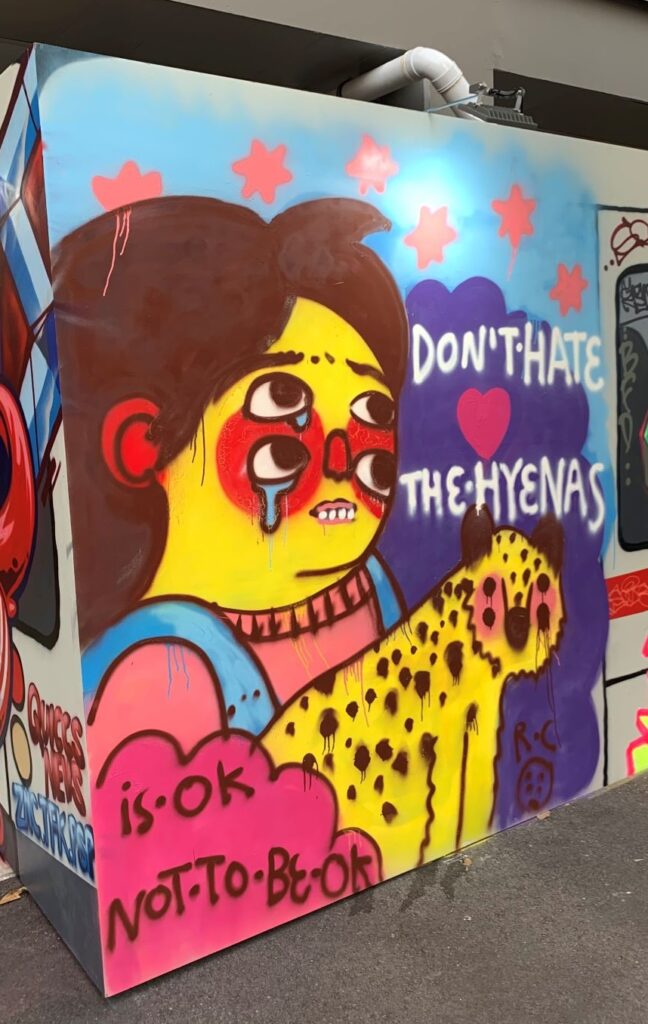
Matt: Your father was an artist.
Ricardo: Yeah. Yeah.
Matt: So was that much of an influence on your career?
Ricardo: Yeah, I mean of course when you’re a kid and you’re imitating your parents, usually my father had to spend a lot of hours drawing and painting. So I did the same at the beginning just for imitation
And I think at some point I was a little bit… I wasn’t so social as a kid so I was spending a lot of time with myself reading books, comics, and I realized that drawing was a really… It was a perfect way of spending that time by myself creating stories and all that.
So since then I was really comfortable there and I knew that my career would be that at some point, drawing or painting, but I would never think about becoming like a professional artist, but I did.
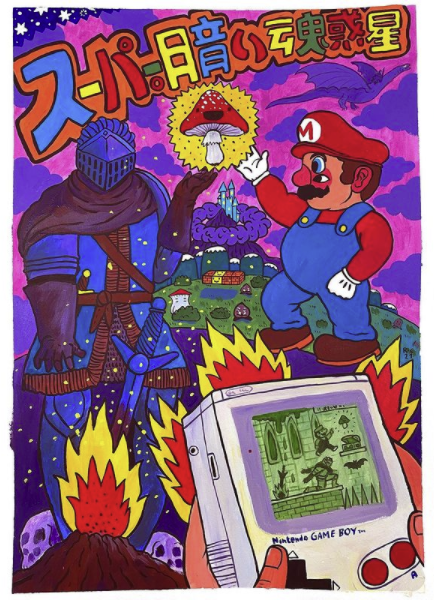
Matt: Did you feel a lot of pressure because your father was an artist?
Ricardo: Not at all, no because he always was really respectful and he never pushed me to be an artist who was just… If he saw that I was happy doing that, he was giving me tips and lessons in some way.
In fact, he at some point quit and became a teacher because he wasn’t able at that moment to be going on to be an artist. So he’s really happy because I made it for now. But the only pressure maybe is he wasn’t able. So when you’re a kid and you see your father was not able to do that, you think I’m not going to be able if he wasn’t able. That’s why I never thought that I will become a professional artist.
So I think that was good because he gave me no stress at all. Its like I enjoy doing this, you will find a work like in an agency or something related with this but not like an actual artist. So I had the time and no stress for having fire me, maybe because of that I became professional.
Matt: Life as a creative is very challenging. I know that too well.
I guess at this point in your career you’re still…you know. You’re in the middle of your career obviously. Are there any, is there any particular project or projects that you are particularly proud of?
Ricardo: Most of them, they’re related with charity organizations. I’m always very conscious about what’s happening in society, different countries. And I knew always that I wanted to give some energy to that type of projects. So I’m happy doing that.
And I don’t know, always anytime that I’m traveling for instance here to the other side of the world because they are interested my work is like, well thank you. It’s really flattering to me, but I can’t speak, like choose just one. I mean anytime that I’m traveling because of my what he’s like, wow thank you for this. Its beautiful.
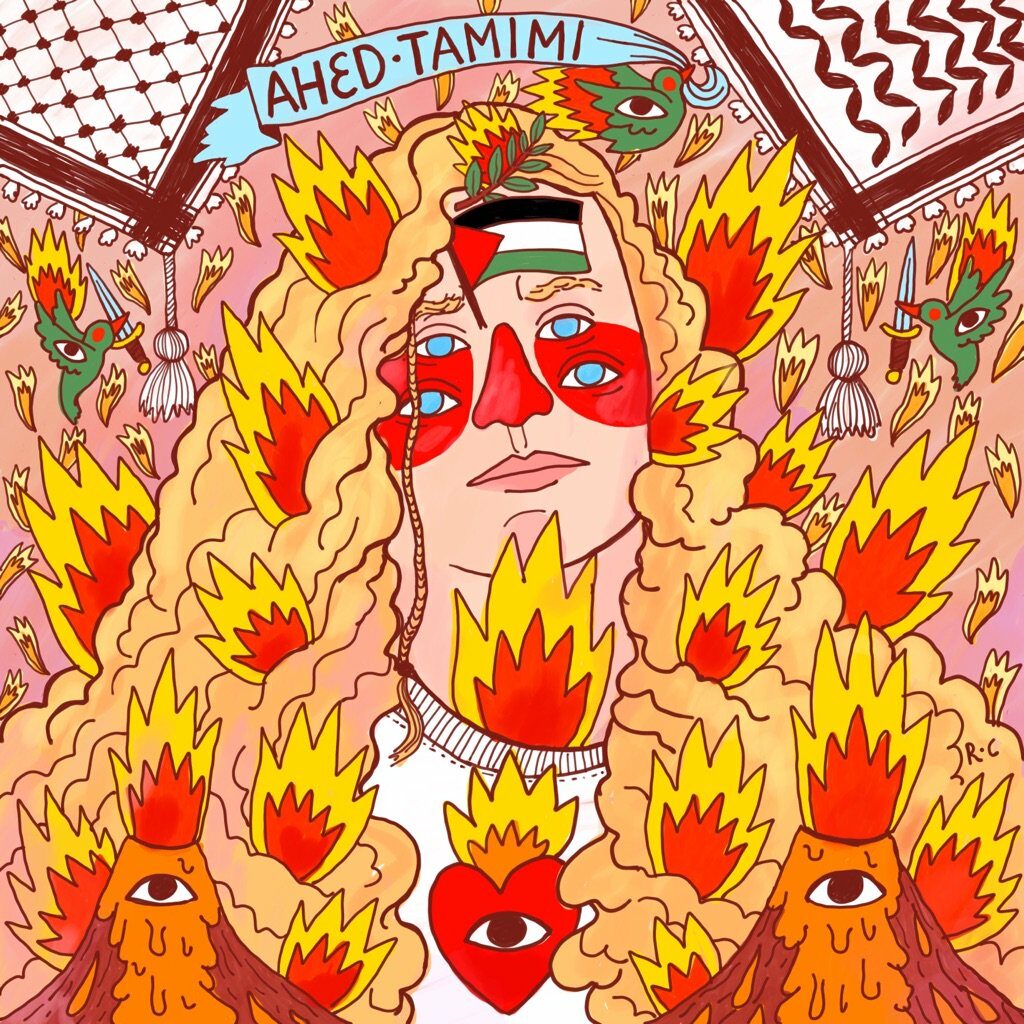
Matt: Exactly.
Ricardo: Yeah.
Matt: It’s very lovely.
Ricardo: Yeah.
Matt: And I guess as we were Spanish, you’re Spanish yourself, how has your Spanish heritage played into your art and your style?
Ricardo: I never saw like my country or society, or culture.
Matt: Yeah, It’s our upbringing, yeah, uniquely as having grown up in Spain and…
Ricardo: Yeah, but in fact most of the people say, oh there’s are a good Mexican connection with my work but I always say that there’s a coincidence. Because they say, “no because of the vivid colors and everything.” But I always more so interested on medieval art and we can find so much medieval art, in particular in Barcelona there’s some museum. The MNAC, the national museum of Catalonia and you can find something unique.
It’s like murals painted on churches in a century, 12th century, 13th… and it’s unique and it’s very naïve and simple but with vivid colors. That’s what I do.
So I paid attention on that but I can’t say my work is like Spanish, you know?
Matt: Yeah, exactly.
Ricardo: I don’t know. Maybe it’s people perceiving it from outside, they can say, yeah maybe vivid colors there is like this… they say like Spain and there is this warmness and everything.
Matt: But it’s never had a specific influence, not that you can identify?
Ricardo: I don’t think so. Not even different cities that I’d been living in, Brighton or Milan or Barcelona, Madrid. I don’t use the city, I use when I traveling.
When I am traveling I’m paying attention a lot but when I’m living, I don’t, I’m just, being there but maybe with my mind in another place. I don’t know.
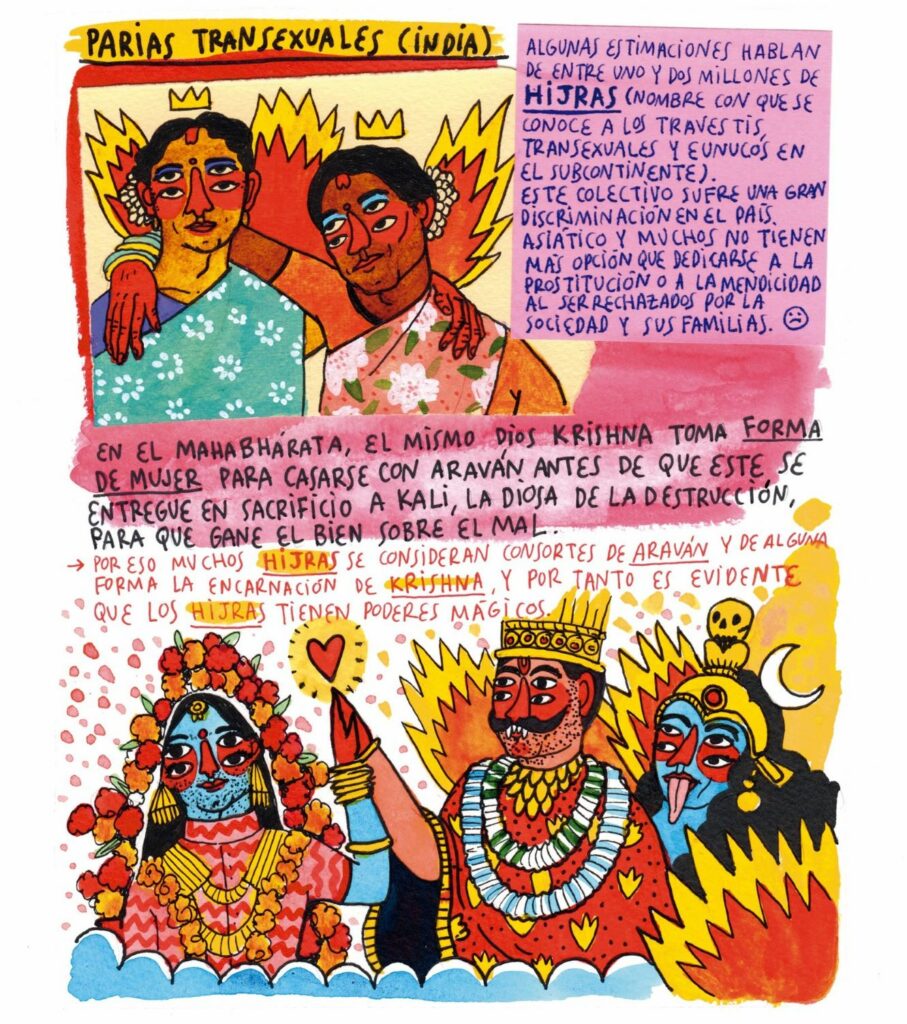
Matt: Are there any particular artists that come to mind that particularly influenced your work?
Ricardo: It’s funny –
Matt: Or even your work ethic?
Ricardo: … yeah, It funny because most of the things that influence my worker’s style, there is no like very important names on that. For instance, I’m really interested in [inaudible] and most of them they’re people anonymous so that’s really interesting. I was also interested in a comic but in a general way, I didn’t have this… I love Kiri’s work or whatever, just in general. I mean I was influenced and maybe more than art, on the way of telling stories with graphics, but there is no like particular names, like I… I’m not, how can I say… like I’m not really paying attention on important names or something like that.
Matt: It’s a good way to be, Yeah. It means you don’t subconsciously copy anyone’s style.
Ricardo: I don’t think so. Well, I can say that for a while I was coping a styles, but just for fun.
I love Hanna-Barbera cartoons in 1940s and when I copy that because its just for fun.
I love medieval art. I’m going to do that because I love it.
I love old school style for tattoos. I was coping on that, just for, not even for practicing, just for having fun.
And I think that at some point I started to mix, hey, why don’t I use the medieval art with the comic twist and maybe using these, but not even consciously, but all of us, we have references before and we’re copying or redoing in some way. Of course.
Matt: Yeah. I guess speaking about sort of pop culture influence. You’ve used characters sort of like Bart, Michael Jordan. You’ve introduced those into your art.
When you’re selecting those sort of characters from pop culture, what influences your decision?
Ricardo: I only, I always choose something attached to me and my life. For instance the last exhibition it was all these, I call them heroes, who was Michael Jordan, Bart Simpson, the toys of Toy Story, SpongeBob.
I don’t know. I of course, all of them, they’re really a famous, but Conan the Barbarian is not so so so famous right now and I will also thinking of him.
I needed to pick people that I really enjoyed or connected with them in some way so it has to be attached to me.
Matt: Yeah. I guess dive If we were to dive in a little bit deeper with your work, sadness and depression.
Omnipresent.
Ricardo: Yeah.
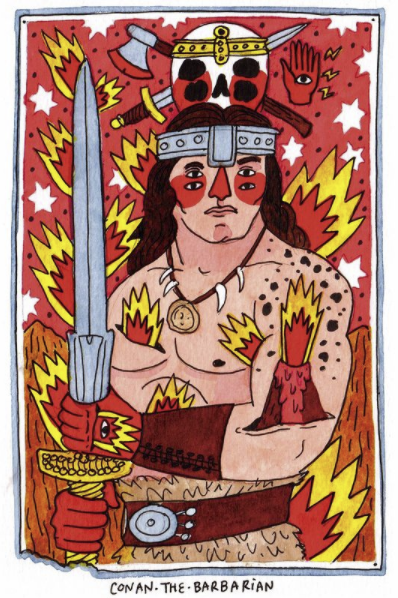
Matt: What inspired you to tackle such deep issues of vulnerability with your work?
Ricardo: Four years ago I was, I was into depression because of exhaustion. I spent all my energy and I had to stop for almost one year before working and just doing therapy.
It was terrible because I almost died on the path but it was really good in terms of I discovered this other part of the world.
I was blocked from trying at some point with my emotions and feelings and the therapy, it helped me a lot. Of course sometimes sad but sometimes until you leave something bad or someone really close to you, you are not conscious about that problem. I did and since then I learned that we really need to talk about mental health in this case as and as I know it my first person while during that year, I want to speak about, I want to talk about it.
I think it’s a good mix with my style so because it’s shocking at some point because the style is like vivid you could say even happy and I really like to create that contrast.
Matt: Yeah, yeah
…Specifically, you’ve collaborated with Mercedes, basically brings the battle of mental illness to the forefront.
How did that project come about and can you take us through the design?
Ricardo: I have to say, you mean the car in particular? They first got in contact with me for coming here and they offer me this project, and I have to say that I always try even for commercial work, try to speak about this subject, mental health.
I wasn’t sure that they were… It would be agree about because you have to keep that in mind.
So I have to say thank you for that, because they took the risk of using a product they are selling to talk about some very deep and sometimes not positive.
So, but I took the risk. I just, it’s true that if I don’t tell you, people this is the subject. Maybe you don’t have to find out, I mean maybe you just say, “Oh, this is a super heroine and she’s killing ghosts or whatever. She’s doing something. But there’s the subject is she’s fighting against obsessions or depression or whatever.”
I created these characters called Ghosty, she a teenager and also gender fluid and I like to show that also, and I have to say thank you because they took the risk to show that with a product.
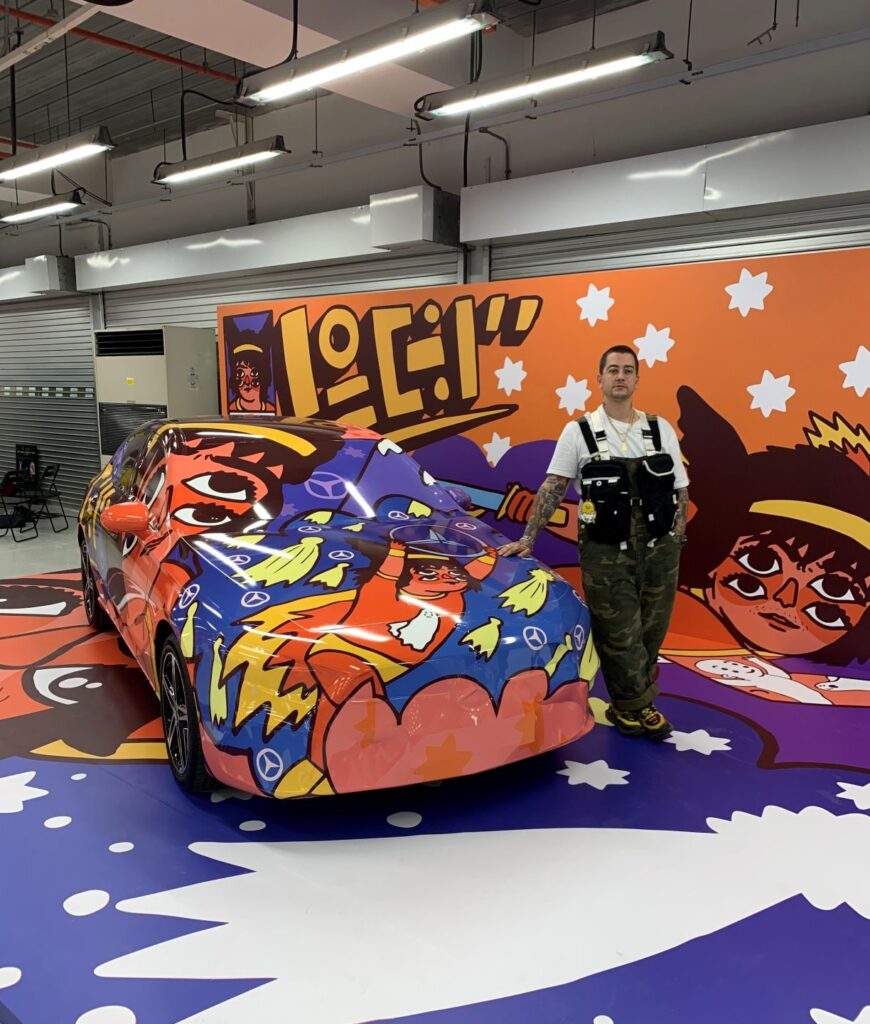
Matt: Just to wind back to what you were sort of saying, with… Sort of had a breakdown and that’s what inspired you with your art to bring to the forefront. Where you ever hesitant to bring to be open about such things?
Ricardo: Hesitant?
Matt: Did you ever consider that maybe you should keep such.
Ricardo: Oh yeah. Okay. No, never. The thing is when I was depressed, those months, anytime that I’m meeting someone, “Hey, I’m kind of, I’m depressed.” I was using that unconsciously, I don’t know why.
Maybe I was thinking, hey, if I tell you what is my position and I’m a situation right now Its not weird for you if I’m down a little bit, so I don’t want to feel you uncomfortable but I don’t want you to think,” what happening with this guy, its me… or. No It’s me, the problem is me right now.”
So since then I learned that the more you talk about it, the more people tell you, “Oh, you know what? I feel the same, but I just speak about this with nobody.” So since then I thought, okay, I’m going to…
Of course I’m shy so sometime you feel a little bit mm but I made a book last year about myself, talking about this. So it was like, “Hey, this is me. This is fucking normal. Its really common so don’t worry about it.”. So since then it’s like, okay, I’m not shy. In fact, I talk about it like being proud of it.
It’s like gallons, at some point. I survived that I learnt.
Matt: I mean, I can relate so-
Ricardo: Yeah. All of us, all of us. That’s the thing.
Matt: That’s the thing.
Ricardo: Nobody talks about it, but all of us.
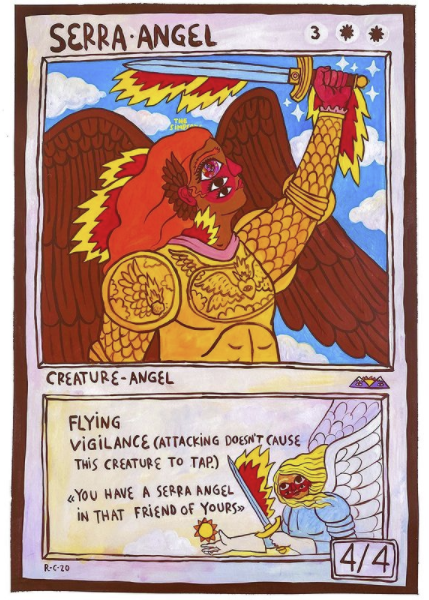
Matt: The big question that everyone talks about is whether it’s becoming more prevalent or it’s just that we’re becoming more open about such topics.
Like whether depression is increasing or whether it’s just that we are more open to talk about it. I mean, I guess it’s…
Ricardo: I mean of course, when I was depressed, I didn’t want to talk about it. I mean, of course, at least in a creative way.
When I was in the depression, I think I was thinking okay I’m learning but I don’t want this my life, so I fuck off. But I learned after that. I mean, in fact you never recover 100%. It’s like, okay, I know that door is here. I’m learning how to keep it closed, which is perfect, and if it’s opening I know what I have to do. I think it’s perfect.
So of course it’s a process when you’re in the middle of that, fuck this, I don’t want this, but now that I’m recover, I feel better, much, much better. I feel strong enough for hey let’s talk about this.
So maybe there’s a cure, at some point you don’t want to talk about it and they respect that, but if you speak about it later, would you feel better and more confident? Do it.
Matt: Exactly. I mean its not something that just goes away.
You don’t just cure it and it goes away.
Ricardo: Yeah. No, no, no, no. It’s always there now.
Matt: Its always an exercise.
Ricardo: But its good because you know I always explain, its like there is a cliff and you’re walking and you fell down in a cliff, “Oh fuck, there was a cliff in here.” Next time, you know there is a cliff so just take care.
Matt: Daily struggle.
Ricardo: Yeah.
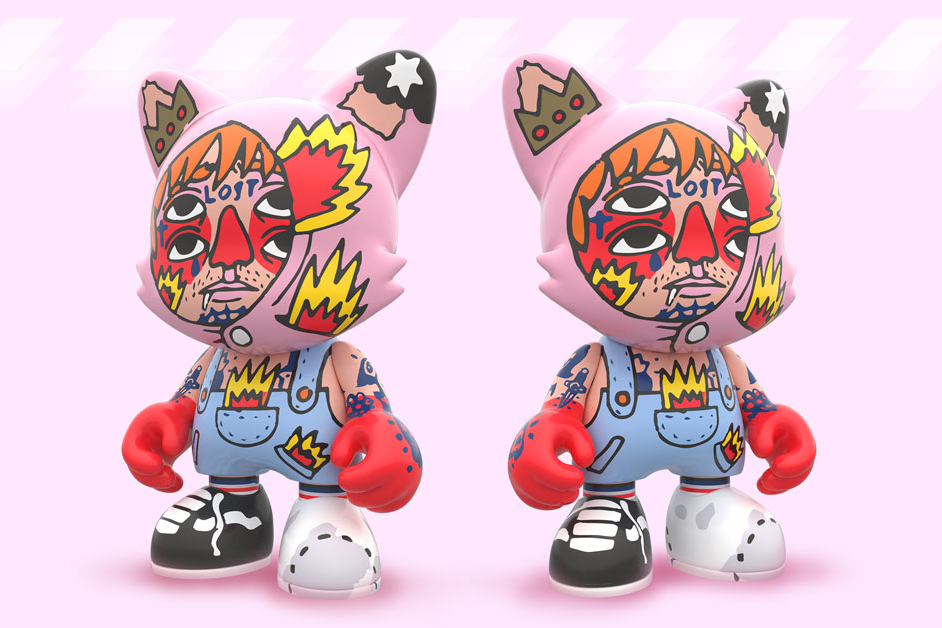
Matt: I guess if we were to just go down to your sort of style, your most signature element I guess is the use of four eyes for characters.
What’s the sort of story behind this visual trademark?
Ricardo: Well, I use a symbology a lot. I like, as I’m shy, if I use symbols and speaking about something maybe deep, but maybe you don’t get it. If you get it, I’m happy you don’t, I’m safe. Okay.
In particular the four eyes, it means it’s something real attached to my life. My parents got divorced when I was three and my mother she got married with a guy, a gypsy guy, and gypsies in Spain in the 80s, 70s, they were not able to read or write most of them because they left school so soon to work with their parents and my stepfather was like that and when I was like, but he was really wise. He knew a lot of things about life.
And I ask you, when you’re a kid you ask in this way, Hey, you can’t read, you can’t write, how do you know that much in my life? And he told me that since he was kid he was from town to town working with his father selling donkeys and he told me the more you see, the more you know, the wiser you are and I love that.
So when I create that character, I love it. I love him, I love her because they are a part of me, of myself. So I’m giving them love, giving them more eyes because you’re more wiser you are more special.
Matt: Makes sense.
Ricardo: Easiest love.
Matt: We’re both four eyes.
Ricardo: Yeah exactly.
Matt: Thanks I won’t keep you too much longer because I know you’re busy man.
Ricardo: Don’t worry your time.
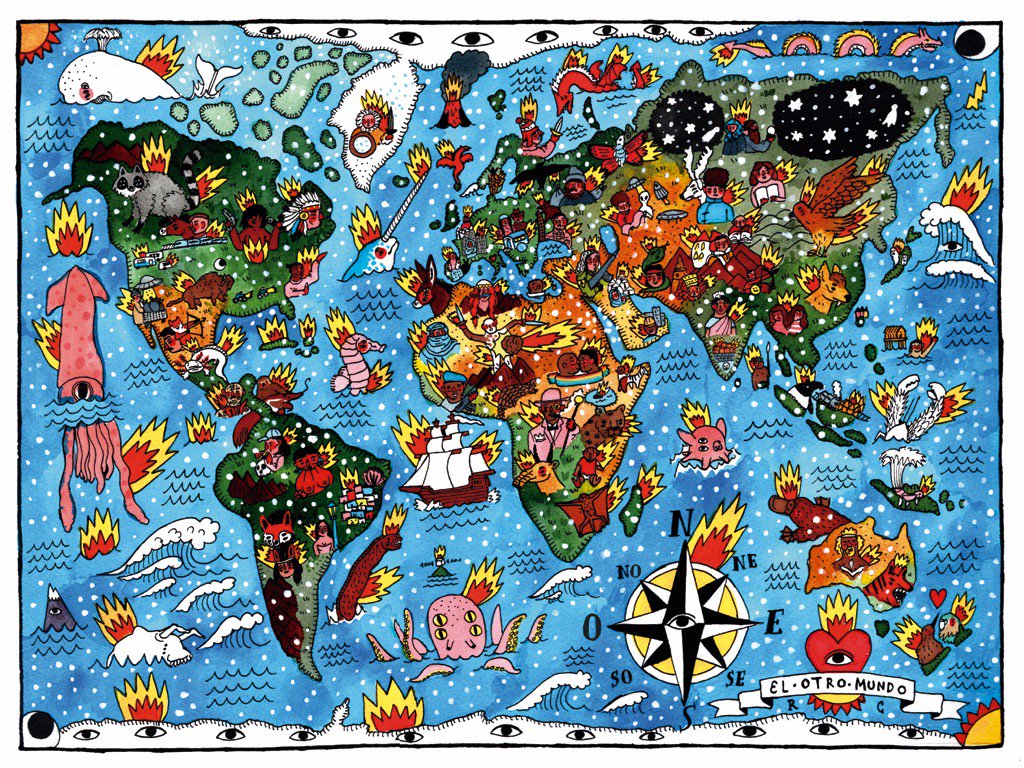
Matt: That’s all good. I mean we’re here in Southeast Asia. I mean I’m from Australia. You’re here from Spain.
Singapore has really established itself as a hub for culture, I’m not sure if you had too much of a time to explore as such, but why do you feel like this sort of region and cities like Singapore are really becoming so supportive of the arts?
Ricardo: Of course necessary. Thank you for doing something like that. This is my second time here and even the first time that I was Singapore, I mean I was the last year here painting some murals, not for the festival and other things and I perceived that maybe Singapore in particular is easier because there’s more money.
I mean there’s money in Singapore, there’s no doubt and I’m not lying if I say that, also art is part of the money wheel at some point because people with money, they buy art and they want to promote someone or they want to support someone. We need that as of course an artist we need so many things but also that, so if you have money, it’s easier to create these type of things.
I need to travel to all the places, to other countries in this part of the world because I don’t know how is their situation with art, but of course being here I was comparing a little bit with Hong Kong. I was there a few years ago and I felt the same.
Its like, there’s a bunch of money here. So you understand there’s so many galleries and there are so many artists…
So I think this is just a product of having money here. Social habit in art.
Matt: That’s good. I mean I haven’t been here in 20 odd years, but I came here earlier this year because [inaudible] …sort of becoming more aware of the support that is in Southeast Asia for these sort of ventures and stuff and its great.
Ricardo: Also because maybe nowadays is easier to arrive here or at least to check what’s happening here through artists, Instagram or whatever. So maybe it’s like, whoa, Japanese art is amazing. It’s been amazing always its just you are discovering right now, but maybe there was already happening so many things here.
Of course there’s happening more things now than maybe 25 years ago, but there is always an interesting scene everywhere, in Australia, in South Africa, in India, Mongolia, whatever. It’s just, if you find it, you don’t find it.
Matt: I know what’s trending.
Instagram is definitely affecting things. That’s how I’ve discovered a lot in recent years.
Ricardo: I’m getting works on commission just by Instagram.
Matt: Yeah. I mean I, the first I saw of your work was from the Kaytranada LP.
Ricardo: Oh, nice. Yeah. That was a really good..
Matt: Amazing album as well.
I mean for you, I guess if we were just to wrap up. I’m very conscious of time with these sort of interviews.
Overall, what do you hope to achieve with your artistic career?
Is there a goal or is there any sort of ambition that you have?
Ricardo: I don’t think that much about it. I mean, to me, my dream is being 80 and still doing this, that’s maybe my goal. Surviving, being an artist until I die, when I will be old, if I do that, it’s going to be…
It means so many things that I’m achieving, huge things because this is a really tough career. So if I get that, if I’m going to be a professional artist until I die, that means a lot of things happening like exhibitions and collaborations with people that I don’t even know yet.
But I think that it’s like I want to do this always. So, but I don’t think I want to get this or I want to do that.
One of my main goals was also, I mean, a clothing brand.
Matt: What is it sorry?
Ricardo: A clothing brand.
Matt: A clothing brand, yeah.
Ricardo: We are doing it for the last two years. We’re starting and warming the engines step by step. I’m really happy with that.
So I don’t think that much about hey, I want to get this, I want to, no. I love what I do every day. So I want that.
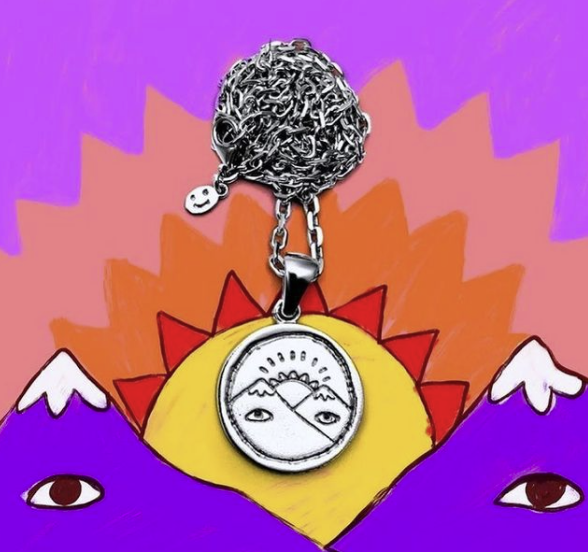
Matt: I think when you’ve gone through sort of the struggles that we have every day is a blessing.
You don’t look to being 80, you just look to next week.
Ricardo: Yeah. I also enjoyed this. No, that’s it. It sounds scary topic, but it’s true, especially when some things happen.
Matt: It’s a weird thing were if you are listening experiences…
Ricardo: Yeah, yeah, yeah.
Matt: Do you, I guess I’ll just ask one more thing.
Do you, do you often receive any sort of messages, I guess from people saying about how your art has influenced them and expressed their emotion?
Ricardo: And it’s beautiful. In fact, the best way that people are sending me messages, “this is our photo for that too, with my art.” That’s beautiful. I mean that’s, I feel honoured with that because it’s someone that in his or her particular moment in their life they felt something, they felt connected with my art and they wanted to celebrate that with a tattoo.
It’s like, hey, I mean we do that for connecting. We are an animal. We need to connect with more like us.
So connecting with my species, is my art, is like thank you for this. So, and also with the all these works that I’m doing for the last months about mental health I’m receiving so many messages like, hey I’m struggling with this.
But especially there is not even the age your art in particular. He’s telling me so many things. No, no, no. It’s just thank you for talking about it.
Matt: Yeah. Yeah. Well.
Ricardo: Which is, I mean, I’m not doing it for that, but if said, if people tell me that, it’s like, okay, so it’s working.
Thank you.
Matt: I think especially for Instagram, I think it helps people to communicate.
All it takes for them…
Ricardo: Because it’s a fucking taboo.
Instagram is perfect for just [inaudible] and showing whatever you want to do. If you’re showing your worst part of yourself. It’s like, Oh, whoa. Thank you.
Matt: I mean like you can just take one of your images and just share it to a friend.
This is how I’m feeling, so…
Ricardo: That’s correct. Yeah. That’s perfect too for that. Yeah.
Matt: Awesome. I’ll wrap it up there.
Links
- Ricardo Cavolo – Online Store
- Ricardo Cavolo – Instagram (Art)
- Ricardo Cavolo – Instagram (Apparel)
- Ricardo Cavolo – twitter
- Matt Williams – Instagram
[The photo of Ricardo used for this interview’s header was taken by Matt Williams.]
